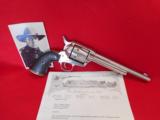

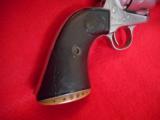
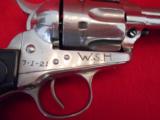
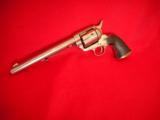
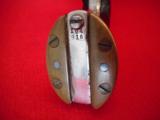
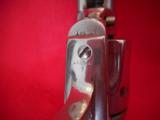

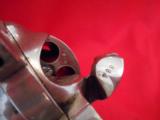
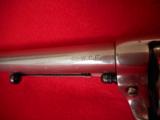

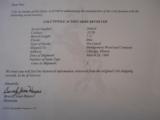

HISTORIC WESTERN COLT SINGLE ACTION ARMY REVOLVER
Guns International #: 100534593 Seller's Inventory #: 1
Category: Colt Revolvers - Single Action Army - 1st Gen - Colt Revolvers - Antique
Seller's Information
When emailing or calling sellers direct, please mention that you saw their listing on GunsInternational.com
Seller: Karlan's Arms & Antiques
Member Since: 11/15/11
State: North Carolina
Country: United States
Phone: (772) 708-0395
Number of Active Listings: 0
Total Number of Listings: 21
Seller: Private Seller
Return Policy: 3 day inspection and return policy on used guns.
3 days
Payment Types Accepted: Cash, cashiers check, money order, wire transfer
About Us: For over 30 years I have been buying and selling Antique Guns (Pre-1898), Military Antiques, Swords, Helmets, Armor, Cannons, Flags, Daggers, Knives, Medals, Accouterments, Militaria, Antiques and Fine Art to the public nationally and internationally. I am interested in items from all nations, wars and conflicts from the 17th Century thru the Vietnam War. You can find me as a regular vendor at various arms and antique shows from coast to coast. I am always available via the web, phone and by appointment. I travel nationwide to purchase collections or single items. Please call, email or text me in order to discuss your needs anytime. Thanks for visiting my site.
Description:
For Sale is a very interesting and all numbers matching historic Colt Single Action Army Revolver reportedly belonging to silent film star legend William S. Hart. This revolver was purchased from a local gun shop from the seller who reported that it belonged to Hart. Like many stories, I quickly dismissed it until I actually saw the revolver which has the initials W.S.H engraved into the side of the frame with the date 7-1-21. When I briefly reserached the date some time ago I found that Hart made four films in 1921 three of which were westerns including The Whistle, Three Word Brand and White Oak. I put the revolver away in the safe for a while in my personal collection and have recently decided to sell it to make room for another gem. I ordered a factory letter and found that the revolver was delivered to Montgomery Ward in Chicago Illinois on March 24th 1900. The serial number is 194816 and is all matching including the gate and cylinder. The desirable 7 1/2 inch barrell lenghth and caliber of 32 W.C.F all matched up to the letter. I was not suprised however that it had been nickle plated along the way some time. My theory is that Hart acquired the revolver, had it plated and had custom grips fitted for one of the films in 1921 in order to add a little flash for the film. The workmanship on the grips is like nothing that I have ever seen and certianly took a great deal of skill to do so. I was told by a fellow collector that there was a certian gunsmith in Hollywood doing grip work at that time which all the stars used but can not recall his name. The right grip does have a hairline but otherwise is solid and free of any other damage. The plating is in very good shape other than some small spots on the left side of the barrell. The gate is nice and tight and the action works and holds at half cock. The colt stamp on side of frame is faint but the barrell markings and caliber is strong. Overall this is a very interesting revolver worthy of more research. There is a William S. Hart museum and history center in Newhall California located at his ranch. I am sure that they likely can provide more information which I have not done to date
Please contact me with any additonal questions you might have and please don't be shy to make and offer as I aim to sell this item quickly. Thanks for your interest and hope to hear from you soon!!
Hart was born in Newburgh, New York, to Nicholas Hart (c1834-1895) and Rosanna Hart (c1839–1909). William had 2 brothers, who died very young, and 4 sisters. His father was born in England, and his mother was born in Ireland. He began his acting career on stage in his 20s, and in film when he was 49, which coincided with the beginning of film's transition from curiosity to commercial art form.[3] Hart’s stage debut came in 1888 as a member of a company headed by Daniel E. Bandmann. The following year he joined Lawrence Barrett’s company in New York and later spent several seasons with Mlle. Hortense Rhéa’s traveling company.[4] He toured and traveled extensively while trying to make a name for himself as an actor, and for a time directed shows at the Asheville Opera House in North Carolina, around the year 1900. He had some success as a Shakespearean actor on Broadway, working with Margaret Mather and other stars; he appeared in the original 1899 stage production of Ben-Hur. His family had moved to Asheville but, after his youngest sister Lotta died of typhoid fever in 1901, they all left together for Brooklyn until William went back on tour.[5]Hart went on to become one of the first great stars of the motion picture western. Fascinated by the Old West, he acquired Billy the Kid's "six shooters" and was a friend of legendary lawmen Wyatt Earp and Bat Masterson. He entered films in 1914 where, after playing supporting roles in two short films, he achieved stardom as the lead in the feature The Bargain. Hart was particularly interested in making realistic western films. His films are noted for their authentic costumes and props, as well as Hart's extraordinary acting ability, honed on Shakespearean theater stages in the United States and England. Beginning in 1915, Hart starred in his own series of two-reel western short subjects for producer Thomas Ince, which were so popular that they were supplanted by a series of feature films. Many of Hart's early films continued to play in theaters, under new titles, for another decade. In 1915 and 1916 exhibitors voted him the biggest money making star in the US.[6] In 1917 Hart accepted a lucrative offer from Adolph Zukor to join Famous Players-Lasky, which merged into Paramount Pictures. In the films Hart began to ride a brown and white pinto he called Fritz. Fritz was the forerunner of later famous movie horses known by their own name, e.g., horses like Tom Mix's Tony, Roy Rogers's Trigger and Clayton Moore's Silver. Hart was now making feature films exclusively, and films like Square Deal Sanderson and The Toll Gate were popular with fans. Hart married young Hollywood actress Winifred Westover. Although their marriage was short-lived, they had one child, William S. Hart, Jr. (1922 – 2004).
By the early 1920s, however, Hart's brand of gritty, rugged westerns with drab costumes and moralistic themes gradually fell out of fashion. The public became attracted by a new kind of movie cowboy, epitomized by Tom Mix, who wore flashier costumes and was faster with the action. Paramount dropped Hart, who then made one lastfor his kind of western. He produced Tumbleweeds (1925) with his own money, arranging to release it independently through United Artists. The film turned out well, with an epic land-rush sequence, but did only fair business at the box office. Hart was angered by United Artists' failure to promote his film properly and sued United Artists. The legal proceedings dragged on for years, and the courts finally ruled in Hart's favor, in 1940.After Tumbleweeds, Hart retired to his Newhall, California, ranch home, "La Loma de los Vientos,” which was designed by architect Arthur R. Kelly. In 1939 he appeared in his only sound film, a spoken prologue for a reissue of Tumbleweeds. The 75-year-old Hart, filmed on location at his Newhall ranch, reflects on the Old West and recalls his silent-movie days fondly. The speech turned out to be William S. Hart's farewell to the screen, and it's a fitting valedictory. Most prints and video versions of Tumbleweeds circulating today include Hart's speech. Hart died on June 23, 1946, in Newhall, California at the age of 81. He was buried in Green-Wood Cemetery in Brooklyn, New York.
SOLD
Curio/Relic: Yes